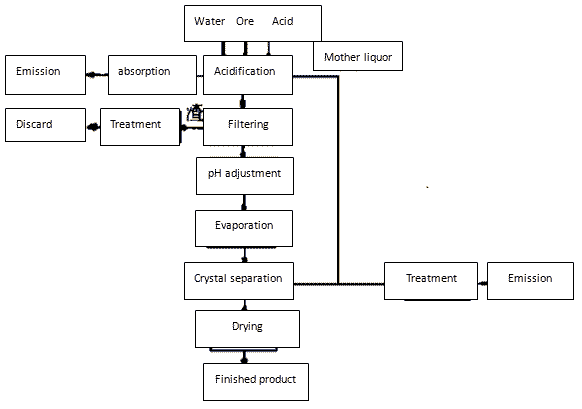1. Hydrometallurgy of galena
Weigh 0.4000 grams of galena in a dry 300ml beaker, add 15ml hydrochloric acid and steam at low temperature to evaporate 3~5 ml; add 10ml nitric acid-sulfate mixed acid, continue to heat and remove it until it is nearly dry. After slightly cooling, add 4 ml of sulfuric acid (1: 1) and wash the cup wall with distilled water to about 50ml. Boil for a few minutes, cool with water, add 10 mL of ethanol, let it stand for 1 hour and filter the precipitate using slow filter paper. Further use dilute sulfuric acid solution (2%) to wash for 3 to 4 times and finally wash with distilled water for additional 1 to 2 times. Discard the filtrate and put the precipitate and filter paper together back into the original beaker; add 30 mL acetic acid-sodium acetate buffer solution and boil until the lead sulfate is completely dissolved. After cooled, diluted with distilled water to 100ml; add about 0.1 gram of ascorbic acid, 2 to 3 drops of xylenol orange indicator and titrate with EDTA standard solution to until the solution color changes from pink to bright yellow which is the titration end.
2. take the metal lead as raw material, first make crude lead nitrate; after the hydrolysis of iron; apply lead replacement of copper, and then carry re-crystallization to obtain it.
(1) the production of crude lead nitrate
Lead ingot is first melted to make lead flower; at the case of slight excess amount of lead, it is subject to reaction with 20% to generate lead nitrate solution to until the reaction solution was light yellow. Filter while hot to remove impurities. The precipitation of the crystalline nitrate salt from the solution include precipitation and evaporation, two ways. 1. Salting-out method: Concentrated nitric acid is added under stirring, and lead nitrate is precipitated due to the common-ion effect. 2. Evaporation method: after applying acidification with nitric acid to the grass green color, apply heating and evaporation to the emergence of crystallization film; the lead nitrate crystals is precipitated out upon cooling; the crude lead nitrate is obtained after centrifugal separation.
(2) purification of crude lead nitrate
The main impurities in crude lead nitrate are iron and copper.
1. hydrolysis for iron removal
The impurity iron in the crude lead nitrate is present as an ionic Fe3 +. The pH value of aqueous solution of crude lead nitrate is 1~2; use ammonia to adjust to until the turbid phenomenon doesn’t disappear as more, the pH value at this time is 3~4. The Fe3 + should be completely hydrolyzed to form Fe (OH)3 precipitate to be removed.
2. replacement for copper removal
Carry out the replacement reaction for cooper removal at the condition of around 50℃.At this time, the solubility of the nitrate lead is 44% while the cooper content in the lead nitrate solution is about 0.025%. According to the Nernst equation, the replacement reaction can be carried out spontaneously. However, since the replacement reaction is carried out in nitric acid and lead nitrate solution (pH1) and the new replaced fine copper powder is more active. In order to prevent the re-dissolving of the nascent copper powder, the lead must be kept in excess. After the lead solution is added, slightly heat to maintain 10~15min, and then quickly filter, otherwise it is difficult to achieve the desired results.
(3). direct synthesis method using lead ore
Lead sulfide ore is taken as raw material and subject to reaction with nitric acid under certain conditions to obtain the lead nitrate solution containing Zn2 +, Fe3 +, Cu2 + and other impurities. This solution, through impurity removal, concentration crystallization, can generate lead nitrate. The mother liquor, after adding potassium sulfate solution, can generate PbSO4 precipitation. After the separation of precipitate, the mother liquor is subject to treatment to remove Zn2 +, Fe3 +, Cu2 + and other impurities and can yield potassium nitrate after concentration. Lead sulfate, under the action of the catalyst, can yield metal lead after iron replacement. The lead then went back and dissolved for making lead nitrate. The reaction is as follows:
3PbS + 8HN03 = 3Pb (N03) 2 + 3S + 2N0 + 4H2O
2HNO3 + K2CO3 = 2KNO3 + CO2 + H2O
Fe3 + 30H = Fe (OH) 3 ↓
Pb (NO3) 2 + K2SO4 = PbSO4 ↓ + 2KN03
PbSO4 + Fe = FeSO4 + Pb
3Pb + 8HNO3 = 3Pb (NO3) 2 + 2NO + 4H2O
Cu2 + + 2OH = Cu (OH) 2 ?.
Zn2 + + 2OH-= Zn (OH) 2 ↓
4. Production of lead nitrate with fine ore powder as raw material
Mineral powder can have reaction after coming across acid, the main reaction occurs as follows:
3PbS + 8HN03 = 3Pb (N03) 2 + 3S ↓ + 2N0 ↑ + 4H2O
side reaction:
3ZnS + 8HNO3 = 3Zn (NO3) 2 + 2NO ↑ + 3S ↓ + 4H2O
3CuS + 8HNO3 = 3Cu (NO3) 2 + 2NO? + 3S? + 4H2O
FeS + 4HNO3 = Fe (NO3) 3 + NO + S + 2H2O
3Ag2S + 8HNO3 = 6AgNO3 + 2NO? + 3S? + 4H2O
As can be seen from the above reaction, with the leaching of lead in the ore, a large amount of impurities also enter the solution in the form of nitrate. Addition of certain amount of precipitant to the acid solution can enable the precipitation and further separation of ions such as Cu2 +, Fe3 + and Ag +.
Process flow chart is shown in Figure 1 below.



